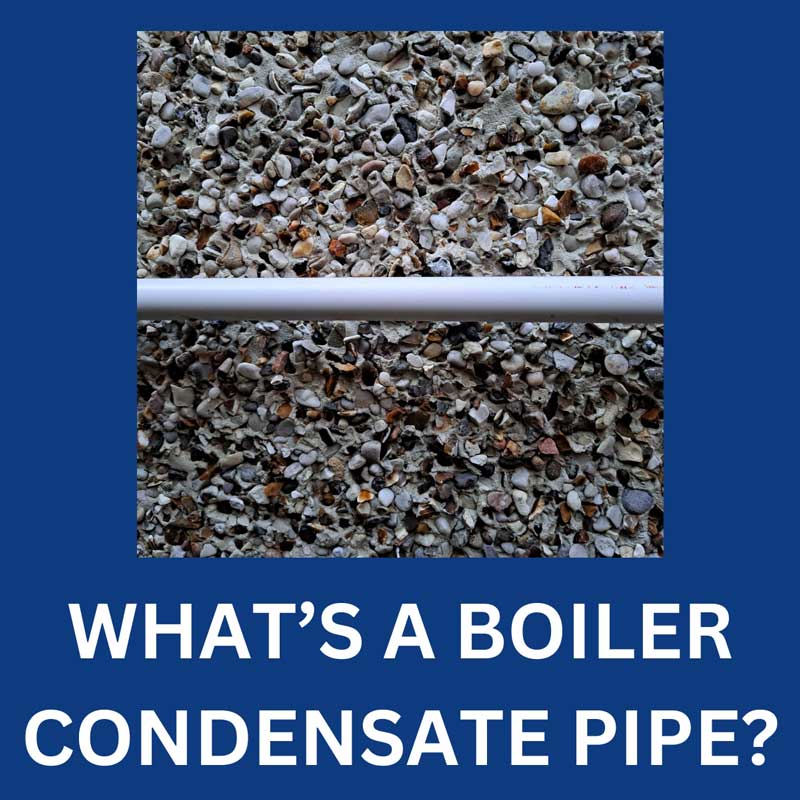
Ever wondered what that white pipe that runs from your Boiler into the drain is? It’s the Condensate pipe. In this article, we’ll go into what it is, what it does and why it’s an essential component of your Boiler.
Before getting into the specifics of the Boiler Condensate Pipe, it’s essential to understand the concept of condensation within Boilers and why it occurs.
What is Condensation?
Condensation is the process by which water vapour in the air is changed into liquid water. In the context of modern condensing Boilers, this process is crucial.
When the Boiler burns fuel to produce heat, this not only heats the water but also has water vapour and other gases. As the heated water cools down, the water vapour becomes liquid, leading to condensation.
Why Does Condensation Occur in Boilers?
Modern condensing Boilers are designed to be highly efficient. This means they extract as much heat as possible from the burning fuel. As they pull more heat, the steam produced during combustion cools down rapidly within the heat exchanger, condensing water vapour.
Managing and effectively disposing of the water produced by condensation is essential, as a typical condensing Boiler produces around two litres of condensate every hour.
What is a Boiler Condensate Pipe?
The Boiler Condensate Pipe is designed to transport the condensed water (or condensate) that forms inside the Boiler during its operation safely away from the Boiler into the drain.
While a boiler system consists of various pipes that manage water and gas flow, the condensate pipe is distinct:
- Purpose: Unlike other pipes that bring water or gas into the Boiler, the condensate pipe’s primary role is to remove wastewater from the system.
- Material: Given the acidic nature of the condensate, these pipes are often made of materials resistant to corrosion, like plastic. This distinguishes them from other metal pipes within the Boiler.
- Location: Typically, the Condensate Pipe runs from the Boiler to an external drain, often positioned externally on a property’s wall.
Importance of the Condensate Pipe
The condensate pipe is an essential component of modern condensing Boilers for several reasons:
Efficiency and Functionality of Condensing Boilers
Condensing boilers are designed to extract as much heat as possible from combustion. When the Boiler burns gas to produce hot water for heating, it produces water vapour. As the Boiler extracts more heat from this vapour, it condenses into a liquid form known as condensate.
Removal of Condensate
The condensate pipe’s primary role is transporting this acidic liquid waste (condensate) from the Boiler to a suitable drain or soakaway. If the condensate wasn’t removed, the Boiler would flood.
Safety
The condensate the Boiler produces is slightly acidic (typically having a pH of 3.5 and 5). This acidic nature is due to the combustion gases (like carbon dioxide) mixing with the water vapour, forming weak acids like carbonic acid. Disposing of this acidic water properly prevents corrosion inside the Boiler.
Environmental & Economical
The condensate also contains residual heat. By utilising this condensate to extract as much heat as possible before disposal, the Boiler operates more efficiently, saving energy and reducing environmental impact.
Regulations & Standards
Modern standards and regulations require efficient combustion and reduced emissions. Condensing boilers, combined with their condensate pipes, achieve these standards by ensuring that as much heat as possible is extracted from the fuel and that waste products are dealt with safely and efficiently.
Prevention of Damage
If the condensate pipe is blocked or frozen, the Boiler shuts down as a safety measure to prevent potential damage to the Boiler or property.
Condensate Pipe Material & Diameter
Condensate pipes are made of plastic, specifically to resist the acidic nature of the condensed water. This choice of material differentiates them from metallic pipes in the Boiler.
In the UK, the typical diameter for a condensate pipe from a domestic condensing boiler is 22mm, the standard size for solvent-weld plastic overflow pipes.
However, larger diameters might be used in some situations or for certain industrial applications.
It’s also important to note that while the pipe diameter is a key factor, there are other considerations when installing a condensate pipe, such as:
- Insulation: The pipe should be insulated if there’s a risk of freezing during cold weather, especially if any part of the pipe runs outside the property.
- Gradient: Ensuring correct gradient helps condensate flow and reduces the risk of blockages or freezing.
- Routing: Ideally, the pipe should be routed internally as much as possible to minimise the risk of freezing.
Potential Issues and Their Solutions
Condensate Pipes can present certain issues, which include:
- Freezing: During freezing weather, the condensate in the pipe can freeze, leading to blockages. Correct insulating usually prevents freezing.
- Blockages: Dirt and debris can cause blockages, affecting condensate flow.
- Leaks: Wear and tear or damage can lead to leaks in the condensate pipe.
Maintenance & Upkeep
You should have your Boiler serviced annually to ensure safety and efficiency. During a Boiler service, a gas engineer will inspect the condensate pipe to ensure it’s in good working order.
If you have any issues with your condensate pipe always consult a qualified heating engineer and never attempt repairs or replacements yourself.
Please get in touch with us if you live in the Essex area and require assistance with your Condensate Pipe or Boiler.

Hi, I’m Terry, the founder and owner of TM Hughes & Son Gas Services
Please get in touch to book an appointment or receive a free, no-obligation quote
Call – 01245 830075
Email – info@tmhughesandson.uk
0% Finance
For Boiler Installations & Repair
